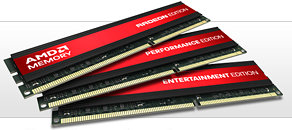- Joined
- Oct 9, 2007
- Messages
- 47,299 (7.53/day)
- Location
- Hyderabad, India
| System Name | RBMK-1000 |
|---|---|
| Processor | AMD Ryzen 7 5700G |
| Motherboard | ASUS ROG Strix B450-E Gaming |
| Cooling | DeepCool Gammax L240 V2 |
| Memory | 2x 8GB G.Skill Sniper X |
| Video Card(s) | Palit GeForce RTX 2080 SUPER GameRock |
| Storage | Western Digital Black NVMe 512GB |
| Display(s) | BenQ 1440p 60 Hz 27-inch |
| Case | Corsair Carbide 100R |
| Audio Device(s) | ASUS SupremeFX S1220A |
| Power Supply | Cooler Master MWE Gold 650W |
| Mouse | ASUS ROG Strix Impact |
| Keyboard | Gamdias Hermes E2 |
| Software | Windows 11 Pro |
In August, we got a first glimpse of AMD Radeon-branded DDR3 memory modules sold at select stores in Japan. At the time, AMD denied plans of directly selling AMD-branded memory to customers, and that it was determining if the sale of AMD Radeon-branded memory through channel partners is a viable opportunity. Today there is concrete evidence that AMD wants to go directly to customers with their DDR3 memory products, and has partnered with two well known companies in its effort.
Presenting a more polished AMD memory module lineup. The first ones (pictured in the link above) looked not much more than bare, generic-looking DDR3 modules with Radeon logo stickers. The new ones look better designed for customers, since good product design pays heavily in the retail channel. The new modules use black colored PCBs, metal heatspreaders, and red colored full-length stickers. A confirmation that these products are headed to the retail channel is the box. OEMs don't buy memory modules in boxes, they buy them in trays. AMD has a nice-looking product box design with a carbon-fiber pattern and appropriate branding.


What does AMD-branded memory bring to the table that most other brands don't? To begin with, AMD claims that they will be rock-stable with AMD processor platforms. Next, they lack Intel XMP profiles, and instead use either high-spec JEDEC profiles, or AMD Black Edition profiles to achieve high DRAM speeds. AMD memory modules are designed to work with AMD Overdrive software to allow fine-tuning of various memory parameters such as clock speeds, voltages, and timings. Also featured are high-speed data transfer based on 8n-prefetch pipelined architecture, Bi-directional differential data strobe (DQS and /DQS), DLL aligns DQ and DQS transitions with CK transitions, and Internal self-calibration.
AMD is partnering two rather familiar brands. First is Patriot Memory, we suspect that Patriot Memory is the OEM behind AMD branded modules. Patriot is a reputed memory vendor among enthusiasts, and can deliver in volumes. The other partner is VisionTek. A well-known AMD Radeon graphics card vendor, VisionTek has the distributor base needed to market these modules. VisionTek could even sub-brand these modules.
AMD has three lines of memory module products, tabled below:

View at TechPowerUp Main Site
Presenting a more polished AMD memory module lineup. The first ones (pictured in the link above) looked not much more than bare, generic-looking DDR3 modules with Radeon logo stickers. The new ones look better designed for customers, since good product design pays heavily in the retail channel. The new modules use black colored PCBs, metal heatspreaders, and red colored full-length stickers. A confirmation that these products are headed to the retail channel is the box. OEMs don't buy memory modules in boxes, they buy them in trays. AMD has a nice-looking product box design with a carbon-fiber pattern and appropriate branding.


What does AMD-branded memory bring to the table that most other brands don't? To begin with, AMD claims that they will be rock-stable with AMD processor platforms. Next, they lack Intel XMP profiles, and instead use either high-spec JEDEC profiles, or AMD Black Edition profiles to achieve high DRAM speeds. AMD memory modules are designed to work with AMD Overdrive software to allow fine-tuning of various memory parameters such as clock speeds, voltages, and timings. Also featured are high-speed data transfer based on 8n-prefetch pipelined architecture, Bi-directional differential data strobe (DQS and /DQS), DLL aligns DQ and DQS transitions with CK transitions, and Internal self-calibration.
AMD is partnering two rather familiar brands. First is Patriot Memory, we suspect that Patriot Memory is the OEM behind AMD branded modules. Patriot is a reputed memory vendor among enthusiasts, and can deliver in volumes. The other partner is VisionTek. A well-known AMD Radeon graphics card vendor, VisionTek has the distributor base needed to market these modules. VisionTek could even sub-brand these modules.
AMD has three lines of memory module products, tabled below:

View at TechPowerUp Main Site
Last edited:




